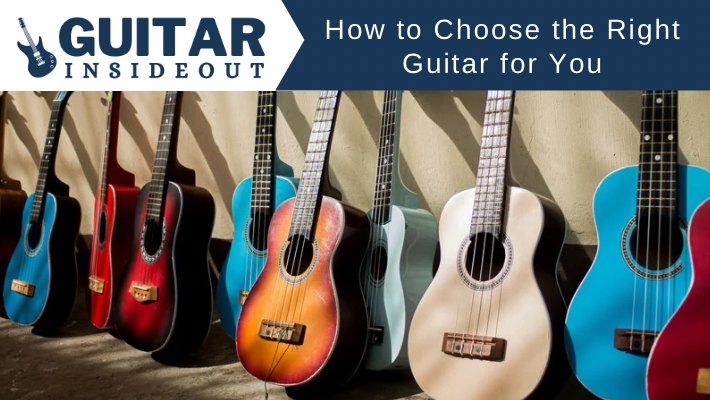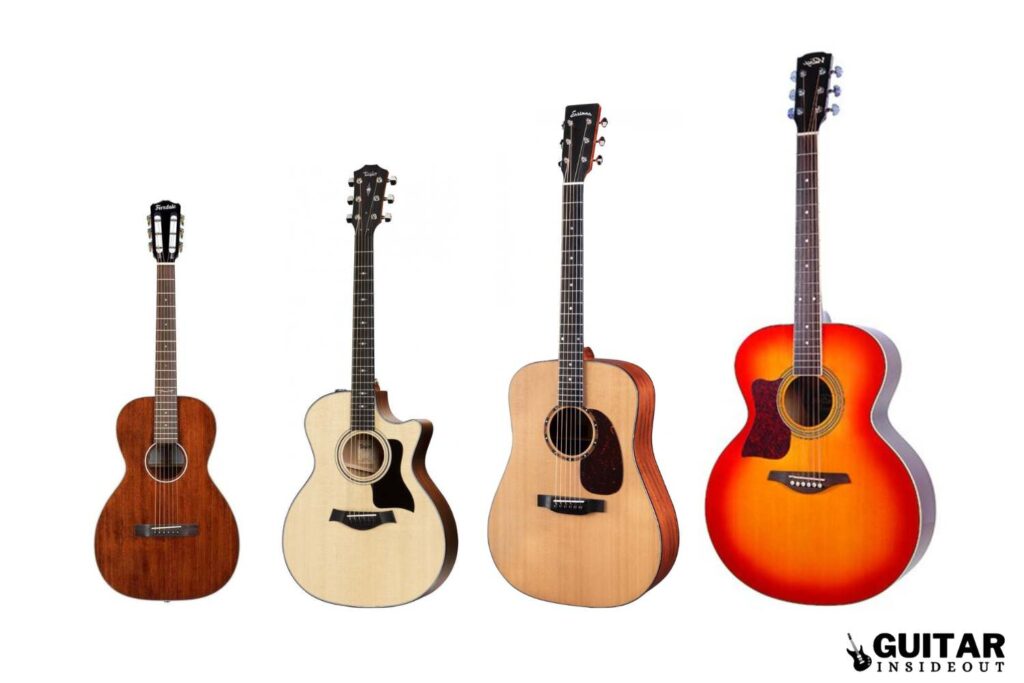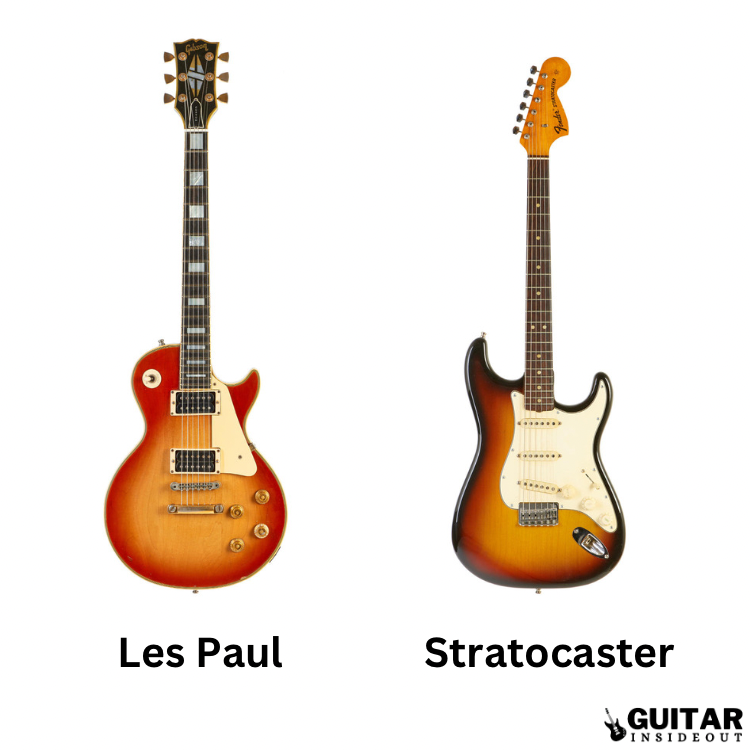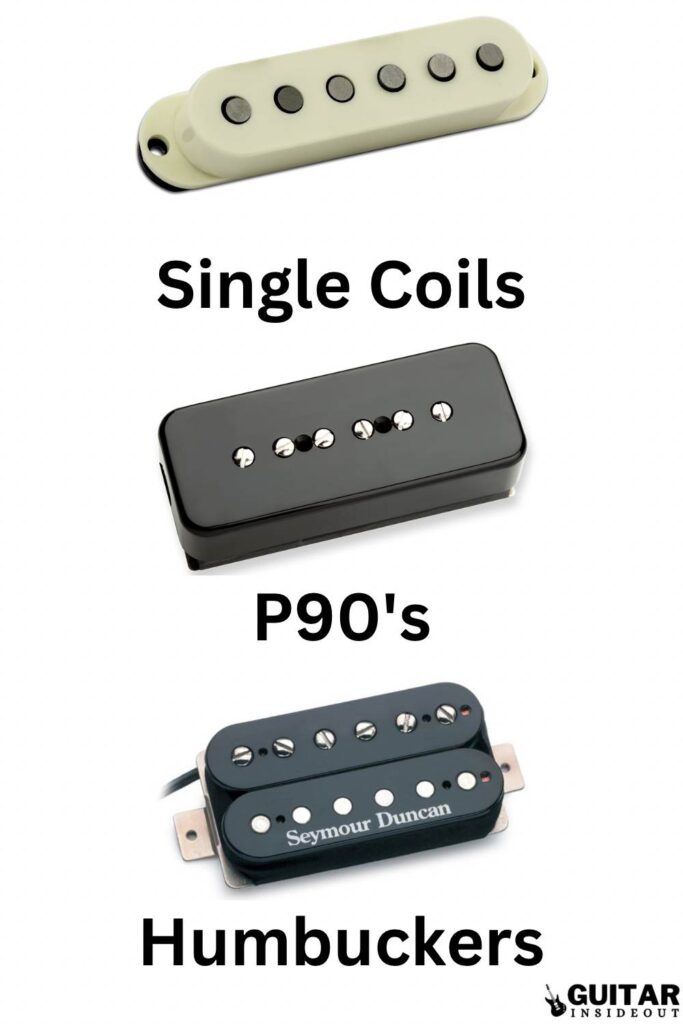Are you ready to rock (or strum, or even fingerpick) but not quite sure which guitar to choose? Don’t worry, I’ve got you covered!
Choosing the perfect guitar can be a daunting task, especially if you’re just starting out. But it really doesn’t have to be.

How? Well this guide is going to make it an absolute breeze. I’ll show you everything you need to know to pick the right guitar for your playing style, budget and more.
Whether you’re a country crooner or a metal shredder I’m going to guide you towards the guitar of your dreams. We’ll look at the basics like deciding on your playing style and setting a budget but also explore some of the more in-depth considerations like neck shapes and pickup configurations.
And don’t be put off if you’re not a guitar wizard yet and all these terms are confusing. It’ll be explained in the simplest language and very easy to understand.
So grab a pick (or your fingers) and get ready to discover how to choose the right guitar for you.
Determine Your Playing Style
Ok, let’s start with the basics. Before you can choose the perfect guitar you need to know your playing style.
So think: are you simply looking to strum chords? Do you want to pick some beautiful and intricate melodies? Or are you more interested in big riffs or shredding like a rock God?
It’s important to know your style and what type of music you are ideally looking to play. This is going to be key to selecting the right guitar that suits that style as well as being easiest to play.
Let’s face it, choosing a classical nylon strung guitar isn’t going to work if you want to play heavy metal, is it? That’s an obvious and silly example to use as no one is really going to make that mistake. But it demonstrates that the genre of music does play a role in which guitar you go for.
But how exactly do you figure out your playing style? It’s very easy.
All you have to do is think about your favorite songs and bands or artists. Essentially what is your biggest inspiration for wanting to get a guitar?
If it’s gentle acoustic fingerpicking you want to emulate or strumming along as you sing then an acoustic guitar is the obvious choice. If you want to play rock or metal you’re going to want an electric guitar, preferably one that has higher output pickups for playing with distortion.
Thinking about these simple questions will help you get a better sense of your preferences and the style you’re going to be playing.
Once you know this you can start looking for guitars that match. For example if you love fingerpicking you might lean towards a guitar with a wider neck and a lighter gauge of strings. Or if you’re into heavy metal you might want a guitar with humbucker pickups for those crunchy riffs and a pointy body shape (because it looks metal!)
So take some time to think about your playing style and what kind of sound you want to achieve. It will make it much easier with finding the guitar that’s perfect for you.
Consider Your Budget
Let’s be honest: guitars can be expensive. I’ve spent more money than I’d care to admit on guitars and gear.
Thankfully though you don’t have to spend huge amounts to get a decent instrument. There are plenty of great guitars available at every price point. So it’s important to decide on your budget early on.
If you’re just starting out you might not want to spend a fortune on a guitar. And that’s totally fine! In fact it’s probably a good idea.
The last thing you want is to discover you don’t like learning or playing guitar and be left with a $1000 instrument you’re going to have to resell at a substantial loss.
Instead there are lots of affordable guitars that are perfect for beginners. As you improve or decide guitar is definitely for you and you’re going to stick with it then you can think about investing in a higher-end instrument.
One thing to keep in mind when setting a budget is that it’s not only the guitar you’ll need. Often you’ll want accessories to go with it (gig bag or case, capo, strings, picks etc), if it’s an electric guitar you’ll need an amp or some way of amplifying it, there can be maintenance and setup costs and you may want lessons rather than teaching yourself.
So be sure to factor all those possible costs in when deciding how much you can afford to spend. It can quickly add up.
Once you have a budget in mind then you can start researching guitars in your price range. It’s generally better to stick with a brand name – Fender, Gibson, Ibanez etc.
Not because brands are necessarily better it’s just there’s a lot of knock offs that are really poor. Buying a no name brand is a sure-fired way to get a guitar that is rubbish, horrible to play and probably make you quit when otherwise you wouldn’t.
You will find that a lot of the well known brands are very expensive though. But most of them have more affordable, beginner oriented sub brands.
For example Fender has Squier, a hugely popular range of more beginner friendly guitars that are priced accordingly. Gibson has the same with Epiphone.
These guitars are a lot cheaper but that doesn’t necessarily make them poor. They don’t use as high end parts for them, the pickups might not sound quite as good and some of the finer details are lacking.
But they’re still really great guitars for beginners. And at prices that don’t break the bank.
A Squier from the ‘Classic Vibe’ range is a really good instrument for the money you pay. I’ve also raved about the Squier Bullet Mustang in other articles which is incredibly cheap considering how good it is.
So don’t feel the need to go for one of the most well known brands. Expensive doesn’t always mean better.
Focus on finding a guitar that feels and sounds great to you, regardless of the price tag or name on it. Don’t forget to shop around either – you might be able to find a great deal on a used or discounted guitar.
Although if you’re a total beginner be careful when buying used as you may miss issues the guitar has.
- Affordable
- Good for small hands
- Sounds great
- Lightweight
Choose Between Acoustic and Electric
The differences between acoustic and electric guitars goes further than how they sound. There’s also the playability factor, weight, loudness etc.
But most important is the type of music you play. As mentioned before if you want to play rock or metal then you don’t want an acoustic and if you want to play folk or classical you’re probably not going to want an electric.
As a very brief overview, acoustic guitars are great for playing singer-songwriter style, folk, types of country, pop etc. They have a warm, natural tone and don’t require an amplifier to play.
They’re generally simpler than electric guitars as they don’t have as many bells and whistles – amplifiers, tone and volume controls, various pickup configurations etc. But acoustic guitars mostly use thicker strings and have wider necks which can be more challenging to play as a beginner.
Electric guitars on the other hand are suited to playing the likes of rock, metal, blues, jazz etc. They have a sharper and more cutting sound, able to go from a clean tone to high gain.
Due to the amplification they can also be played at much higher volumes than acoustic guitars. They have more versatility as well and can use effects pedals or different amps to get a range of tones and sounds.
If you’re not sure which to go for then it’s a good idea to try both out. You will probably find you gravitate towards one more than the other. It might be because you prefer the sound or find one easier to play.
Select the Right Size
Playability is a big part of finding the right guitar. And so the size of a guitar is important to consider, especially if you’re a beginner.
You don’t want to end up with a guitar that is too big, uncomfortable to hold or too heavy. If so you won’t enjoy playing it, will probably pick it up far less and are much more likely to give up and stop playing quickly.
Acoustic guitars come in a wide range of sizes. They go from the smaller body’s of Parlor and Concert guitars through to medium body’s like Auditorium and Grand Auditorium and large body’s such as Grand Orchestra and Jumbo.

It’s very difficult to decide which body size will be best for you without trying them first. If you’re going to get an acoustic guitar then playing each of the sizes and shapes is recommended.
Electric guitars on the other hand don’t have different names for body sizes. But they do have different body shapes which differ depending on the brand and model.
For example a Fender Stratocaster has a very different body to a Gibson Les Paul. You might find one more comfortable to play than the other due to the body shape and the weight.

So when selecting a guitar it’s important to try out different options to see what feels most comfortable. Take the time to try as many as you can.
Sit down with them, see how they feel in your lap and against your body, how the weight is etc. Make sure you can comfortably reach all the strings and play without strain.
Getting a guitar you find comfortable is key to enjoying and learning. You won’t make any progress if it’s awkward to play, so don’t be afraid to experiment and try different sizes until you find the perfect fit for you.
Neck Shapes and Profiles
The shape and neck profile of your guitar makes a big difference. The neck is the part of the guitar where your hand will spend most of its time so it’s very important it feels comfortable.
These are the most common neck shapes and profiles:
- C-shaped necks – The most common neck profile, C shaped necks have an oval profile that feels comfortable in most players’ hands. They’re a popular choice for players who play a mix of chords and lead and are found on lots of Fender guitars.
- V-shaped necks – The V-shaped profile is more angular than a C-shaped neck. They can be quite polarizing and are preferred by players who have use a substantial grip on the neck or their thumb over the top a lot.
- U-shaped necks – Often referred to as “baseball bats”, U shaped necks are chunky and suit players that have larger hands.
- D-shaped necks – a flatter version of the C shape, the D shaped neck is thinner and ideal for playing fast and moving around the fretboard easily.
Finding the neck shape that is right for you comes down to trying out the various profiles. You will notice a difference when you switch between guitars with various neck shapes and it will quickly become clear which feels best in your hand.
It’s definitely one of the more important parts of making sure a guitar is suited to you. You can change guitar strings easily, its very to cheap to buy a load of different pick sizes to try out, but changing necks is costly and awkward if you’re a beginner. So you’ll want to get it right.
Pickups and Electronics
If you’re going to get an electric guitar then you need to know a little about the pickups. The pickups convert the vibrations of the strings when you strum or pick them into an electrical signal that gets sent to the amplifier
The pickups also have a big influence on how it will sound when it’s amplified. There are different types of pickups and then different configurations in electric guitars which all have their own tonal characteristics.
Types of Pickups
- Single-Coil Pickups: Known for having a bright and clear sound. They are often associated with genres like pop, country and some rock.
- Humbucker Pickups: Designed to cancel out the hum (hence the name) and noise that you can get with single-coils. They have a thicker and warmer sound and are popular in genres like rock and metal.
- P90 Pickups: are a sort of middle ground between single-coils and humbuckers. They retain much of the brightness that single coils are known for but with some of the warmth and thickness you find in humbuckers. You can get a nice mix of going from clean and smooth to quite a sharp and aggressive gain.

Choosing which type of pickups to get in your guitar will be down to the type of music you want to play and the sound you like. Metal and rock – go for humbuckers. Pop, funk, R&B and country – single coils. If you like a lot of genres P90’s might be for you.
But those are only guides. Lots of artists have used single coils for metal or humbuckers for country. You shouldn’t be constrained by stereotypes. Go with what you like the sound of.
Active vs. Passive Pickups
It’s worth noting that pickups can be either active or passive. What that means is active pickups require a battery to operate and tend to have a hotter output. For this reason they’re used in higher gain types of music – mostly metal.
Passive pickups on the other hand don’t require a battery and are generally simpler in design. They’re far more common and found it the most popular and well known electric guitars.

Pickup Configurations
Now you know the types of pickups you need to be aware of the configurations they come in. Many of the same models of electric guitars come with different pickups.
For example you can get a Fender Stratocaster with the traditional 3 single coils (known as SSS) but also with one humbucker and 2 single coils (HSS) or simply 2 humbuckers (HH). For a closer look at these configurations see this guide to the differences between HSS vs SSS vs HSH pickup configurations.
Why there are so many variations is they all sound different and are suited to different styles. Being able to mix and match the various pickup types gives you more options.
Electronics
In addition to the pickups the electronics of the guitar can impact the sound and playability:
- Volume Controls: self explanatory, this controls adjusts the overall volume of your guitar.
- Tone Controls: Most electric guitars have at least one tone control. They let you adjust the treble or bass frequencies.
- Pickup Selector Switches: If the guitar has multiple pickups it will come with a pickup selector switch that lets you choose which pickups are active.
For more information about electric guitar controls try this guide to what the guitar knobs do.
These controls give you more or fewer options depending on which you go for. They’re not going to make a huge amount of difference to the overall sound or feel of the guitar but make up the whole package.
Wood Types and Their Impact on Sound
If you’re a beginner then the type of wood a guitar is made from and it’s impact on tone isn’t something you should dwell on for long. The debate around the effects of wood, especially for electric guitars, is long and mostly tedious.
But it doesn’t hurt to go through some of the most common woods and what they sound like. And if you’re going to get an acoustic guitar then the choice of wood plays a big part of how it sounds.
- Spruce: Probably the most popular choice for the top (soundboard) of acoustic guitars due to its bright, dynamic and resonant sound. Spruce is lightweight and strong too which makes it a durable option.
- Cedar: Another popular choice for acoustic guitar tops with a warmer and darker sound than spruce. It’s also softer and more fragile so often paired with a stronger wood for the guitar’s back and sides.
- Maple: Known for its bright and snappy tone, maple is often used for the back and sides of acoustic guitars. It’s also a popular choice for electric guitar necks and bodies due to its stability and ability to produce bright, sustained tones. (I love a maple neck on my electrics)
- Rosewood: A very popular choice for the fretboard of electric and the bridge of acoustic guitars, as well as for the back and sides. It has a rich and warm tone with a strong bass response and lots of sustain. A quite heavy wood though and so not used is solid body electric guitars.
- Mahogany: Often used for the back and sides of acoustic guitars, as well as the neck and body of electric guitars and basses. It has a warm and rich tone with a strong midrange and is fairly heavy.
Overall the wood type isn’t going to be a huge factor in your decision. But being fully informed of each types characteristics can help if you want to avoid certain heavy weights or tones.
If you’re trying out a guitar then don’t be afraid to ask questions and try different models with different wood combinations.
Test Drive Guitars
Once you’ve narrowed down your choices and found a few guitars that you like in terms of budget, size etc. then it’s time to test them out.
Whilst you can buy online without playing one first, especially seeing as many stores let you return a guitar, it’s definitely best to try in person and play it yourself.
Unless you physically put your hands on the guitar, feel it’s weight, how it sits on your lap or against your body etc. you can’t know if you’re going to like it.
So try to get to a store and play them. Even if you come home and order your choice online.
You might even want to take a teacher or friend who knows more about guitars than you. They can provide some feedback on how good the instrument is, how it sounds and if the price is fair.
When you test a guitar keep these few things in mind:
- Play different styles – if you’re a complete beginner this might not be possible. But if you can then either try playing different styles of music or get someone else to do it for you. This allows you to see if the guitar works for the types of music you like and how versatile it is.
- See how it the feels – pay close attention to the weight and balance of the guitar. Does it feel good in your hands? Does the neck feel comfortable? Can you play it standing up and for long periods of time? These are all the sorts of things you should be testing out.
- Check the tuning – Make sure the guitar stays in tune. Play some chords and check if they sound right. A good guitar should have good intonation and stay in tune even if you play for long periods of time.
- Listen to how it sounds – how the guitar actually sounds is obviously one of the most important aspects when buying it. You aren’t going to want a guitar you don’t like the sound of. So see if it produces the sound you have in mind.
Consider Your Preferences
One of the last considerations you should make when choosing a guitar are your own personal preferences. What I mean by that is how the guitar looks, any brand you particularly favor and additional features you have you heart set on.
In the past I was of the opinion that the appearance of a guitar didn’t matter. What mattered was how it played and sounded.
And whilst that remains true I have come around to the idea of how a guitar looks being important. Why? Because a guitar that you find appealing, that stands out and that you think looks cool/beautiful/funky/whatever is going to make you pick it up and play it.
Simple as that. It works the other way too. A guitar you find ugly or boring you’re going to play less. So the appearance does matter.
That doesn’t mean you should choose a guitar entirely on how it looks. That’s a recipe for disaster. But it’s appearance and ‘wow factor’ should be a part of picking along with everything else mentioned here.
Brand reputation might also be worth considering. Some well known guitar brands have a reputation for producing high-quality instruments but they also come with a higher price tag.
So do your own research, watch YouTube videos and read reviews to get a good sense of which brands are known for making quality and reliable guitars snd which to avoid.
Lastly think about any extra features that you might specifically want. For beginners it’s usually best to stick to simple and straightforward at first rather than get something complicated.
But you might want to look at something like a starter pack that comes with a strap, gig bag, tuner, picks etc. These can be useful because you’re less likely to make a mistake buying the wrong items if they all come together.
But sometimes the guitars that are part of the packs aren’t as good as the ones you can buy individually. So it’s a balance and my suggestion would be buy the guitar and accessories separately if you can as you’ll probably end up with a better guitar overall.
Choosing the Right Guitar and Making an Informed Decision
I hope this guide and the tips and advice provided have helped you to feel more confident making your choice. Buying a guitar can be daunting for those who don’t know what to look for, all the terms and jargon invoked and what’s the right amount to spend.
Remember that choosing a guitar is a personal process. What works for one person may not work for another.
But by thinking about everything covered here you should be able to make a well informed decision that will help you get a guitar you will enjoy playing for years to come.
Whether you’re a beginner or an experienced player finding the right guitar can make all the difference in your enjoyment of the instrument. So it pays to put the hard work in, do proper research, reach out to others and ask for advice to help you with that decision.
I wish you the best of luck and really do hope you find that perfect guitar!

This is one of the best articles I’ve seen on guitar selection.
I’m leaving the beginner phase with a beautiful guitar that was gifted to me by a professional guitarist. It is a hollow body electric and I’m looking into a solid body now to vary my blues and old school R&B jamming.
I’ll definitely be looking to you for more articles!
Really glad you liked it and thanks for the kind words!
A solid body for blues and R&B – it’s got to be a Strat, right?